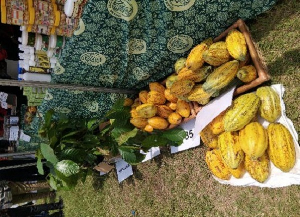Addressing Child Health Service Concerns: Efforts in Upper East Region
The 2011 Multiple Indicator Cluster Survey (MICS) reported the Upper East region as having the highest under-5 mortality rate in the country. The region recorded an alarming 34 deaths per 100,000 Live Births, a figure above the national average of 32 deaths per 100,000 Live Births. In other words, one can view the region as the worse and most dangerous place to be a child in Ghana.
This statistics came as a surprise because prior to the 2011 MICS survey, the Upper East region was the best performing region in reduction of under-five mortality as indicated in some previous surveys. For instance in the 2008, Ghana Demographic and Health Survey (GDHS), the region recorded under-five mortality rate of 17 deaths per 100,000 Live Births, something that was lauded at the time considering that the Upper East region in the last two decades has been the nurturing grounds for some of the national and global interventions that have revolutionized child health care in this country. Notable among these are the vitamin A Supplementation trial, the implementation of Accelerated Child Survival and Development (ACSD) project, the discovery and nurturing of the Community-based Health Planning and Services (CHPS) health system delivery model. These interventions among a host of others were tested in the region including works and studies by the Navrongo Health Research Centre (NHRC), one of the reputable research centers in the world.
So for everyone who is familiar with the region’s health sector performance in major health interventions, the 2011 MICS report sent many scratching their heads for possible reasons that might have led to the dramatic change of events.
But health authorities in the region say they saw the MICS survey report as a challenge to do more in what the region knows best, find sustainable, high yielding, easy to replicate health care innovations and interventions that would impact largely on the overall health systems and particularly child health and survival. And indeed recent run of events in the region has shown that they did not take the poor showing in the MICS report lightly.
“We are up in action, and indeed to the task, doing many great things, and hope to put the Upper East region back on track as one of best performing regions, that is where we belong” the Regional Director of Health Service Dr. Koku Awoonor-Williams, told journalists at a recent media briefing. The media event which was held to update journalists on child health care activities in the region was also used to appreciate them for the effective and massive coverage they provided during the national launch of this year’s Child Health Promotion Week which took place in Bolgatanga.
Dr. Awoonor-Williams told journalists at the media encounter that the Annual Child Health Promotion Week is an important event on the health calendar: a period necessary to provide extensive education and child health services to millions of children across the country. He noted that as the current national best performing region in reducing maternal mortality (135 deaths per 100,000 Live Births which is far below the national average of 350 deaths per 100,000 Live Births), the Upper East region has every opportunity to add on significant reduction in under-5 mortality to its host of best performing indicators. “What we have realized over the years is that having done so well in child health care in the mid-90s to the early 2000s, we skewed most of our programs and focused heavily on maternal health unknowing that we were probably making significant loses in some gains made earlier.
Gladly, we have identified some of the factors that accounted for the region’s recent poor showing in under-5 mortality and have since put in place appropriate measures to ensure we keep both our mothers and their babies alive when they come to deliver in our facilities”
Dr. Awoonor-Williams lamented that one of the major challenges facing child mortality in the region was neonatal mortality. He said close to 50% of the under-5 deaths recorded occurred during the first 28 days of the life of the baby. As a result of this intriguing revelation, the region has launched a huge onslaught on neonatal mortality. “The idea is that if we can get all our babies surviving in their first 28 days of life, we are sure to keep them alive in the first one year and when that happens chances are that they would live to celebrate their 5th birth day” he observed.
According to the Regional Director, the region has in the past few years initiated a number of interventions aimed at significantly reducing neonatal mortality and promotion of general child and maternal health care. He enumerated some of the measures to include improvement in emergency referral, engaging communities, community sensitization and education on harmful cultural and traditional practices, the training of staff in newborn and life-saving skills, training of community-based health volunteers as agents of change in newborn and maternal health care and the provision of essential equipment especially for newborns and neonatal resuscitation.
Commenting on essential equipment and logistics, Dr Awoonor, revealed that two hospitals in the region namely the Bolgatanga Regional Hospital and the Navrongo War Memorial Hospital were recently supported by UNICEF to establish and operationalize state of the art Neonatal Intensive Care Units (NICU) and are currently providing specialized care for sick babies. Training and basic logistics for newborn care have also been provided for some midwives and community health nurses across the region.
On efforts made to improve emergency referrals, the Regional Director disclosed that in the spirit of determination and innovation, the Upper East region hopes to soon overcome its long standing problem with poor transport and communication network currently hampering emergency referrals. This follows the success and growing popularity of the Motor King Ambulance initiative introduced by the Regional Health Directorate recently. The innovation which involves the use of modified tricycle as ambulance and mobile phones for emergency communication is currently being scaled up from initial one sub-district to three districts out of the 13 in the region.
The intervention according to the Regional Director has proven to be a life saver and very appropriate for the rural terrain. He hinted that in the Upper East region there are less than 10 ambulance stations for the 1.1 million populations with operations in mainly the city and town centres because there are no access roads in most districts and communities and said the innovation has been found to be sustainable and designed to be owned by communities.
Dr. Awoonor added further that the significant improvements in child health services in the region are also attributable to intensive sensitization of communities and the efforts of volunteers trained in providing community level education on danger signs in newborns and pregnant women, including the importance of seeking early care, the use of insecticide bet-nets and education and sensitization on harmful cultural and traditional practices.
He lauded UNICEF, the Japan and Korean governments as well as the Doris Duke Charitable Foundation and Comic Relief for their support and contribution to the health sector in the region.
Health News of Sunday, 6 July 2014
Source: Mathias Aboba-Bolgatanga












